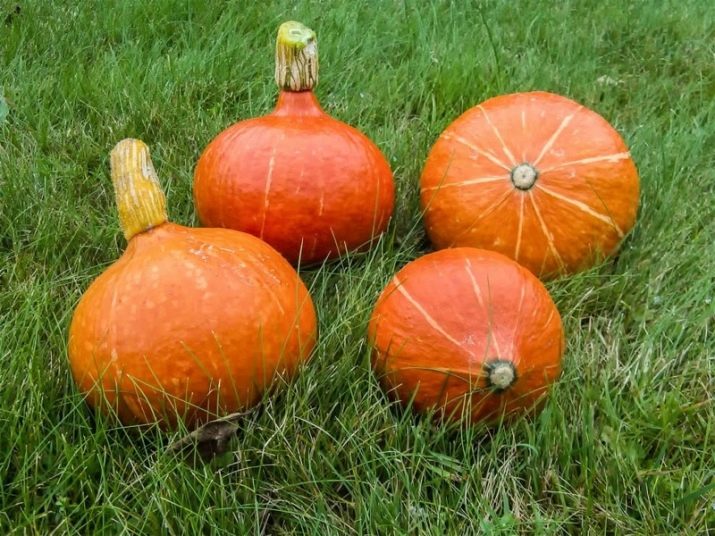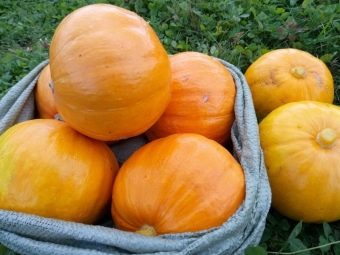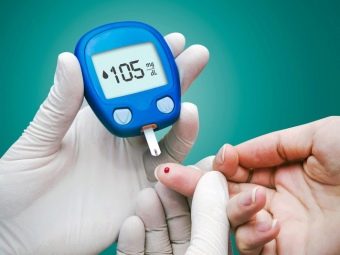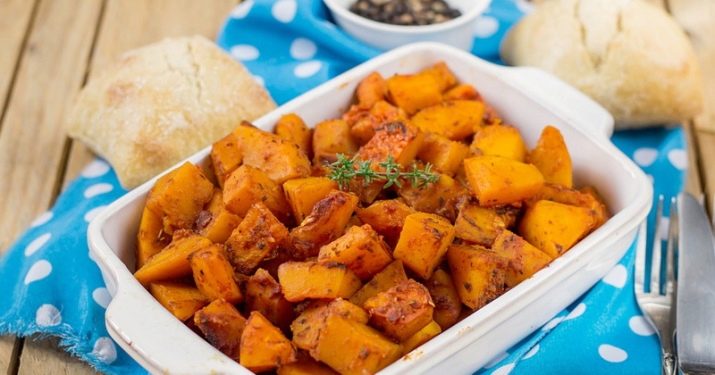What is useful pumpkin?

Pumpkin occupies a leading position among other fruits and vegetables in the content of vitamins and minerals.It is possible to find in it vitamins K and T, which are rarely found, but extremely important for the body. The vegetable has a tonic, strengthening, diuretic effect and is indicated for various ailments.
Vegetable, fruit or berry?
Pumpkin is a herbaceous plant of the pumpkin family. There are annual and perennial varieties of it. The plant has a clinging stem on the ground and large, rough leaves covered with small hairs.
During flowering, bright inflorescences are formed, which are collected in bunches or are arranged singly. After flowering, the fruit is formed, which grows as it grows. The fruit is covered with a dense orange shell. Inside contains soft pulp with seeds.
Botanists call pumpkin a multi-seeded berry (like cucumber, zucchini), agronomists claim that it is a vegetable. In everyday life, pumpkins are usually also considered a vegetable.
Its homeland is South Mexico, where it was cultivated about 5,000 years ago. Indians used pumpkin pulp for cooking, squeezed oil from seeds, and the skin served as dishes.
Kinds
Cultivated pumpkin has many varieties. It should be noted that only table varieties should be eaten. In addition to them, there are feed varieties (grown for livestock) and decorative (used to decorate the site).
Among the vegetables suitable for consumption, it is possible to distinguish the following main types:
“Ordinary Dough Meadow”
Fruits are formed on powerful stems (length can reach 7 m) with large loops (antennae). Such pumpkins are distinguished by early ripeness, but good keeping quality. Small fruits have a fairly dense skin, which is very difficult to remove from a raw plant. Pumpkin shape - elongated, somewhat egg-shaped.
The taste of hard-bodied pumpkins moderately sweet, different versatility of use. It is this type of vegetable that has become most prevalent in Russia, which is largely due to its unpretentious care.
Among steadfast pumpkins are well known varieties such as "Marble", "Children's delicacy", "Almond".
Hokkaido
Another type of early ripe pumpkin. This species is bred by Japanese breeders and is a small pumpkin with sweet pulp. In taste, the latter resembles sweet potatoes or chestnuts. Fruit size rarely reaches 2.5-3 kg, the shape is slightly flattened or pear-shaped. The bark can be either light orange or more saturated, with reddish hues. There are also varieties of "Hokkaido" with beige, grayish or pinkish skin.
"Muscat"
This pumpkin is also called pear-shaped, due to its shape. Vegetable has a slightly elongated, fairly elegant outlines. This type of pumpkin is widely used in cooking, especially for the preparation of sweet dishes and desserts, because it has delicate honey pulp with a high sugar content.
Such a pumpkin has fewer seeds and a rich orange hue of the pulp and peel. Among the shortcomings - a shorter shelf life, as well as sufficient "capriciousness" in the care. Butternut pumpkins are thermophilic, demanding to care.
The most famous "representatives" of the nutmeg type are the Arbat and Batternat varieties.
"Large-fruited"
From the name of the species it is clear that the fruits grow overall. Its weight can reach 15-20 kg, although there are cases of growing such a pumpkin weighing 100 kg. However, there are varieties of large pumpkins weighing 2-4 kg. Form - round, sometimes slightly flattened from the poles.
Despite the high sugar content, large pumpkin has a good keeping quality. This is largely due to the dense and thick skin of the vegetable. Taste characteristics are average, characterized by versatility of use.
This variety is also widely used, due to simplicity in the care, high yield and good keeping quality. Among the most popular varieties of large pumpkins can be identified such as "Rossiyanka", "Grace", "Centner".
"White"
Another option that can be stored for not only the entire winter period, but in some cases 2-3 years, without fear of changing the taste of the vegetable. This variety is also called white or wax. This results from the fact that in process of maturing green color turns into white, and on its surface dense wax raid is formed. It is thanks to the latter and ensures good quality of the pumpkin.
Pumpkin weight - no more than 4 kg, the shape is round, slightly elongated on the sides. The peel has a whitish color with a green tint and a characteristic whitish with blue patina.
Recently, thanks to the breeders' efforts, new pumpkin varieties have appeared. The most interesting is the Chinese bitter gourd or, as it is also called, bitter cucumber, Karelia. The shape of the vegetable is similar to zucchini (has an oval shape), green skin and light whitish-green flesh.
Initially, the taste of Karelia has a pronounced bitterness, but as it ripens it becomes sweet. Amazing are the seeds of the fruit, which have different sizes and shapes.
The leaf-shaped pumpkin tastes like the fruits of watermelon, and besides, it is very attractive in appearance, therefore it also becomes a decoration of the site. From its advantages can be identified simplicity in care, frost resistance.
Composition and calorie
Pumpkin consists of pulp, constituting about 75% of the mass, seeds (10%) and peel. The content of the latter is 15%. The latter, as a rule, is not eaten. In addition to the pulp and seeds, sometimes eat the stem and inflorescences.
Calorie vegetable is small and equal to 22 kcal per 100 g of raw product. The basis of the composition is water (91.8 g). The balance of BJU looks like 1.0 / 1.0 / 4.4. The chemical composition is represented by vitamins, microelements, sugars, pectins and fiber.
The benefits of pumpkin - in the richness of its mineral and vitamin composition. It includes a natural antioxidant - ascorbic acid, which also has a tonic and immuno-strengthening effect.
Vitamin T is not often found in fruits and vegetables. Meanwhile, it participates in the digestion of food, helps prevent anemia, improves blood clotting and participates in blood formation, forming platelets. A sufficiently large amount of vitamin T is contained in the pumpkin.
Another rather rare vitamin K for vegetables is also found in the pumpkin. It promotes the production of protein and its transport to the formation of the blood and bone system. Vitamins of group B, tocopherol, vitamins D, F, PP are also present in the composition.
The bright orange hue of the vegetable is due to its beta-carotene content. This provitamin is known as one of the products for maintaining visual acuity. The content of beta-carotene pumpkin surpasses even carrots and apricots.
Macro - and trace elements are iron, potassium, calcium, magnesium, phosphorus, cobalt, copper. Their deficiency provokes severe dysfunctions of organs and systems.
In the pumpkin there is fiber, necessary to increase the activity of intestinal motility, improve digestion. Sweet vegetable flavor due to the presence of sugars in it.
Beneficial features
Pumpkin has anti-inflammatory, vasodilator and wound-healing effect. Regular consumption of pulp provides a calming effect, improves the work of the digestive tract.
Pumpkin is able to maintain at the right level the water-salt balance of the body, because it has gall and diuretic properties. This allows us to recommend it for liver and kidney diseases. Puree from steamed or baked pumpkin is often included in the menu for pyelonephritis, cystitis, urethritis.
Pumpkin contributes to the removal from the body of excess fluid, as well as toxins and toxins. Contrary to the opinion that sometimes occurs, the vegetable does not strengthen, but weak, therefore it will relieve constipation.Due to the presence of vegetable fibers, the vegetable improves digestion, preventing the appearance of a feeling of heaviness, bloating, heartburn.
Being a low-calorie product and at the same time contributing to the improvement of digestion, its acceleration, elimination of toxins and toxins, pumpkin is very useful for losing weight. Nutritionists recommend including pumpkin dishes on the menu at least 3-4 times a week for those who want to get rid of extra pounds and improve their body.
Potassium present in vegetables strengthens the heart muscle, stabilizes its activity, relieves puffiness and strengthens blood vessels. In addition, the presence of pectin allows the vegetable to clear the vessels of cholesterol plaques, increase the elasticity of the vessels. Pumpkin will be especially useful for older people with atherosclerosis and varicose veins, and for those who lead a sedentary lifestyle.
Due to the presence of iron and vitamin A, pumpkin is indicated for use with anemia. Its regular use allows you to maintain the level of hemoglobin. At the same time, we should not forget that vitamin A is a fat-soluble vitamin, so you need to use pumpkin by smearing it with vegetable or butter.
When used externally, pumpkin gruel improves skin condition for eczema, dermatitis. In cosmetology, it is used to relieve fatigue in the legs, soften the skin on the heels, heal cracks.
These properties are characteristic of raw vegetables, however, and during heat treatment, it retains most of its useful qualities. Interestingly, one of the characteristics of a cooked pumpkin begins to dominate.
So, baked pumpkin actively removes sodium salts from the body, demonstrates the bile and diuretic effect and delicate laxative effect. It is recommended for people suffering from obesity, as well as diseases of the heart and blood vessels.
Boiled pumpkin will help with lung diseases, it will relieve old cough, and with external use it will moisturize the skin.
Dried, as well as baked pumpkin displays bile and has a slight diuretic effect. It is recommended to use it with increased physical and mental stress, to improve digestion.
Eat-rich seeds can also be eaten. They also contain proteins, phytosterol, protein, organic acids, zinc. The important point is that during thermal exposure these substances are almost completely destroyed. Eating pumpkin seeds is needed raw or dried. They can be put in salads, mashed with honey or used as sunflower seeds.
Pumpkin seeds are recommended for angina and other heart diseases. They have antiparasitic action, relieve helminthiasis. To do this, they can be eaten on an empty stomach, but it is better to prepare milk from the pounded seeds with the addition of honey and water. The treatment complex also includes the use of magnesium sulfate dissolved in water and cleansing enemas.
Pumpkin milk is also recommended for the treatment of diseases of the urogenital system, pain of urination.
Pumpkin juice contains a large amount of B vitamins, and therefore acts as a natural sedative and hypnotic. Enough to drink a glass of pumpkin juice with honey before going to bed to forget about insomnia. In this process will be natural - it does not cause daytime sleepiness, reduce concentration, addiction.
Due to the ability to remove edema, a small amount of juice is recommended to drink daily for problems with the kidneys and liver, diseases of the urinary system. Similar recommendations can be given for constipation, gallbladder disease.
Lotions using pumpkin juice make eczema and dermatitis, long healing wounds, rashes of various origins, burns.
Pumpkin oil is also prepared on the basis of pulp and seeds, which is notable for its easy digestibility, rich in proteins, fatty acids and minerals.In general, it has the same effect as pumpkin pulp - it demonstrates immunostimulant, bile and diuretic, laxative effect, has the ability to cleanse and restore the body, improve digestion.
Pumpkin flowers are sometimes used for severe colds, for the treatment of cough. To do this, based on them, they prepare a decoction or bake inflorescences with dough, like flat cakes.
Pumpkin is useful for women who want to have beautiful skin, strong nails and healthy hair. The presence of antioxidants, vitamins and minerals in it allows you to stay beautiful and slow the manifestation of age-related changes.
During pregnancy, pumpkin or juice from it will enrich the body with vitamins and other "benefits", as well as relieve nausea and other symptoms of toxicosis.
Finally, the pumpkin helps to get rid of excess weight. You can regularly include it in the diet, adhering to the principles of proper nutrition or arrange the days of pumpkin mono-diet. The latter will help, if you need to quickly lose weight, but it should not be forgotten that any express diets are stressful for the body. You can resort to them no more than once every 3-4 months, and their duration should be no more than 5-7 days.
Due to the low calorie content and the presence of fiber, the pumpkin “drives off” those extra pounds, removes water and slags. A high content of vitamins and minerals in it supports the body in this difficult period for it.
As a rule, pumpkin mono-diets assume the use of not only this vegetable, but its combination with zucchini, cucumbers, and bell pepper. From fruit it is citrus. You can not completely exclude carbohydrates - buckwheat, chickpeas must be present in the diet. The same applies to animal protein - chicken breast, turkey, low-fat varieties of fish. Instead of tea and coffee you need to drink herbal teas, kefir. Be sure to drink water.
For men's health, pumpkin is also useful. Ground dried seeds can be used as aphrodisiacs. Regular consumption of orange vegetables helps to increase libido, and its diuretic and antibacterial effect reduces the likelihood of diseases of the urogenital system.
When prostate are used enemas based on oil or vegetable broth. Sometimes used candles made from ground seeds and high-quality butter, taken in equal proportions.
The mass of nutrients contained in a pumpkin makes it useful for children. Vegetable normalizes the work of the digestive tract, strengthen the nervous system, relieve excessive irritability, help strengthen the immune system.
Contraindications
Despite the fact that the pumpkin contains a large number of useful components, in certain cases it can harm the body. It is contraindicated in the first place to those who are allergic or idiosyncrasy vegetable.
From its use should refrain in the presence of ulcers, gastritis with low acidity. In the period of exacerbations of other diseases of the digestive tract organs, it is also better to refuse pumpkin. In its raw form, it is not worth it to those who suffer from flatulence.
The high content of sugars in vegetables can make it dangerous for people suffering from diabetes.
Like any product, pumpkin must be consumed in reasonable quantities. When overeating pumpkin, as evidenced by the reviews, can not avoid problems with the stomach - pain and cutting in the stomach, flatulence, feelings of bloating and stool disorders. These symptoms may join nausea and vomiting, a feeling of weakness.
The permissible dosage of this product in the absence of contraindications - 200-300 g per day.
Is it possible to eat raw?
As a rule, pumpkin is subjected to heat treatment, but you can eat it raw. Moreover, in the absence of heat exposure, the vegetable gives the body maximum of nutrients. As a rule, juice is squeezed out of a raw vegetable. You can also use raw pumpkin in salads, slicing it into thin slices.
A simple version of a vitamin salad involves the use of carrots, pumpkins, and apples. All ingredients must be fresh. They need to be cleaned and rubbed with straws (it is good to use carrot grater in Korean for this). Mix the ingredients, season the salad with a mixture of lemon juice and liquid honey.
An important point - fresh pumpkin shows great biological activity, so it demonstrates a more pronounced diuretic and laxative effect.
The stomach of every person is not able to process vegetable fibers that are not softened in the process of quenching or roasting. This, in turn, can cause abdominal pain, colic, provoke increased gas formation.
Pumpkin is contraindicated in diseases of the stomach and reduced acidity of gastric juice. Do not give a vegetable in this form to children, as well as during illness or during the recovery period. The body spends more energy absorbing a raw product.
Cooking options
Pumpkin can be baked in the oven, boil on steam or in water, stew. To eat it is better to choose a medium-sized vegetable, its skin should be dense, not have traces of rot or pinkish spots.
The pumpkin itself is characterized by a neutral taste, so it is recommended to be salted or cooked with sugar, honey. You can cook the whole pumpkin or cut into pieces. From this, by the way, depends on the cooking time.
A medium-sized whole pumpkin is cooked for at least 1.5-2 hours. Chopped in halves or large pieces - from 40 to 60 minutes, small pieces will be ready in about half an hour.
It is not necessary to peel off the vegetable peel before cooking. Firstly, in its raw form, this will be a rather laborious process, and secondly, the pumpkin cooked with the skin is tastier and more fragrant. Remove the skin from the finished pumpkin is much easier.
As a tonic and tonic, you can make pumpkin juice with honey. To do this, pumpkin weighing 3-5 kg should be cleaned, cut into small pieces, and then skipped through a meat grinder. In the resulting puree make 1-2 kg of honey and mix everything thoroughly. Next, you need to insist a mass of 10 days, stirring occasionally. Keep it at this time you need in the refrigerator. After the specified period, the mixture must be squeezed out after 2-3 layers of gauze. Juice consumed daily in 50 ml 3 times a day (can be diluted with water), and the pulp thrown away.
During the period of recovery from diseases, especially if the course of treatment with potent drugs was completed, it is recommended to prepare such a composition. Take a pumpkin of medium size, cut off the top and remove seeds and pith from the fruit with a spoon. The resulting “potty” needs to be filled with liquid honey, covered with a “lid”, and the cut place should be sealed with dough. To insist 10 days, and on the eleventh to begin reception. Dosage - 3 times a day for a tablespoon, a course - 3 weeks.
To improve the functioning of the digestive tract, their strengthening and recovery, it is recommended to eat pumpkin porridge several times a week in the morning. You can add honey if it is not allergic.
To make porridge, you need to take 700 g of pumpkin pulp and 2 apples, peel and cut them into small cubes. Next, boil rice, millet or corn porridge in milk or water, add vegetable and fruit pieces to it and stew on the fire for another quarter of an hour. At the end of cooking add salt, sugar. Serve with butter.
It is recommended to include pumpkin soup in the children's menu (by the way, it is not forbidden for adults to eat this dish). Cook it easy enough. To do this, 250 g of pumpkin and 3-4 potatoes need to be cleaned and boiled in water until tender. You can boil the vegetables first and then peel. Next, they need to be turned into a puree using a blender, gradually pour the milk into the mixture until the consistency of soup-puree is obtained. Salt, pepper and then on the fire until boiling. Serve with crackers, decorated with a sprig of greens.
Pumpkin puree is an excellent complementary food that can be introduced into the baby’s diet already from 6-7 months of age.To obtain a more delicate texture, you can add a little breast milk or formula in puree.
Fritters can also be made from vegetables., for which 0.5 kg of pumpkin must be cleaned and grated, and then boil it with two cups of milk until ready. Cool the resulting composition, enter into it 1 egg, 2 tablespoons of granulated sugar and so much flour to get a thick enough dough.
You should fry fritters in the usual way, spreading a small amount of dough on a hot, oiled frying pan. As soon as one side of the pancakes is browned, you can turn them over. Serve with honey, sour cream.
For evening tea or an unexpected arrival of guests, you can make pumpkin pie. It does not take much time to cook and consists of available products. First of all, you need to prepare the filling, for which a pound of pumpkin is rubbed on a medium grater and mixed with half a glass of raisins and dried apricots. You can add sliced orange or lemon slices, add walnuts. In the filling you need to put sugar to taste.
Puff pastry need to roll out, put in shape, forming the sides. Chop the dough in several places on the bottom, then lay out the stuffing. Top to make a lattice of dough, cover with foil and bake the cake for 30-40 minutes. 10-15 minutes before being ready to remove the foil so that the dough will brown. You can grease it with egg yolk to get a beautiful golden crust.
By the way, if you mix in the dough for baking (any) some pumpkin gruel (for example, rubbing a piece of vegetable on a fine grater) or juice, the baking will turn out fragrant and beautiful. Pumpkin will give its pigment.
Pumpkin can make a delicious and healthy dessert - jam. This will require 3 kg of pumpkin pulp, which must be cut into small pieces, mixed with three oranges and one lemon sliced with zest. Pour the composition of 1 kg of sugar and boil over low heat for 2-3 hours, stirring occasionally.
Pumpkin goes well with dried apricots, so on their basis you can also cook jam. Pumpkin pulp in the amount of 1 kg should be grated on a coarse grater. Dried apricots pour boiling water, then finely chop. Mix the ingredients and fill with 2-3 glasses of sugar (adjust the amount of taste, because dried apricots also gives sweetness), let stand 30-60 minutes until juice appears.
Stir the mixture, put on the fire and bring to a boil, then boil for 5 minutes. Allow to cool for an hour and repeat the steaming procedure. After cooling to arrange the third "five minutes".
Blanks for these recipes are not intended for long-term storage. They can be expanded on sterile jars and close the capron lids to eat no later than 3-4 months from the time of cooking. For jam, it is better to take early ripe pumpkin varieties, since they are sweeter.
You can also make marmalade from the pumpkin, which will be to your liking primarily to children. First you need to bake the pumpkin, then extract 1 kg of pulp from it. You can get it right with a spoon, without worrying about how beautiful and neat it will be.
The specified amount of pulp along with about 5 kg of sugar should be put in a thick-walled pan or stew pan. Put on the fire and boil until the sugar is completely dissolved. By this time, the pumpkin mass will thicken and decrease in volume. If it does not become homogeneous, you can additionally punch it with a blender without removing the dishes from the fire.
From the finished mass to stick balls and roll them in powdered sugar. You can add in the process of boiling vanillin and orange zest.
You can bake small pieces of pumpkin with sugar in the manner of candied fruit. To do this, clean the raw vegetable and cut into cubes, sprinkle with sugar and send to a baking sheet laid with baking paper. You need to bake at low temperatures - no higher than 100 degrees for about 40-60 minutes. The pieces should stop giving off the juice when you press them with your finger, but they should not be dry, burn.
You can sprinkle pumpkin with lemon juice, and instead of sugar, use honey. The latter will make candied fruits more tender, but one cannot hope that it will increase their benefit. The fact is that about 300 useful components contained in honey are destroyed when it is heated. That is, in this recipe, it acts exclusively as a sweetener.
Pumpkin is actively used not only as desserts and sweet toppings, it also goes well with meat dishes. For example, you can make a side dish of pumpkin. To do this, you need to cut it large enough (it is better to remove the skin beforehand), rub it with salt and pepper, mix with rosemary or basil sprigs.
Grease the foil with a little oil and wrap the pumpkin in it. Bake about 30-40 minutes, 5-10 minutes until ready to unfold the foil.
You can cook a delicious and fragrant dish, which with its serve will surprise guests and household members. To do this, you will need to take a pumpkin for 2-3 kg, wash it and cut off the top. From the pumpkin remove the pulp and seeds and turn it into a "pot". Grate its walls with vegetable oil, salt and spices.
The filling for it will be pork, which must be pre-cut into slices and fried until half cooked with onions, salt and spices. Cook buckwheat, mix it with meat. Then you should stuff the vegetable with buckwheat with meat and send to the oven for an hour at 200 degrees.
You can get a lighter dish using chicken breast. Like pork, you need to fry it with onions and spices, you can add sliced mushrooms. Chicken goes well with rice. In this stuffing, you can add a certain amount of pumpkin pulp, also cut into strips or cubes.
Put the stuffing into the prepared “pot” and cook it in the same way as the buckwheat version.
Lovers of sweet porridge can be recommended as a filling for pumpkin to use rice cooked until half cooked, sliced pumpkin pulp, grated carrots, raisins, dried apricots and pieces of oranges. You can put sugar or honey.
Pumpkin in Greek can serve as an appetizer, and a side dish. For its preparation, the pulp should be cut into cubes and fry for 5-7 minutes in oil. Season with salt and dried basil, at the very end of roasting, add garlic pressed through a press. Put the mixture in a baking dish, pour in some white wine, water or broth (about 50 ml), cover with foil and send to the oven for 30 minutes at 200 degrees.
While the pumpkin is baking, it is necessary to cut the olives into thin ringlets. Sprinkle the finished pumpkin in Greek style with olives and serve.
From pumpkin you can also prepare a sauce for meat or side dishes. To do this, chop the raw flesh into a medium-sized and fry in garlic oil (throw the chopped head of garlic into the hot oil, fry the garlic and, after giving the butter its flavor, extract). To the pumpkin make pieces of tomatoes without skin, onion, salt and spices. Extinguish a little, adding water or broth if necessary, then knead the vegetables with a spoon or punch with a blender. In the latter case, you get a more uniform sauce. The first option will appeal to those who love sauces in which pieces of vegetables are felt.
Most children reluctantly eat baked pumpkin. The same can be said about other products, such as cottage cheese. However, if you combine them in a casserole according to a special recipe, the child will gladly eat them, even without feeling in the finished dish.
For cooking casseroles Pumpkin must first be cleaned, cut into slices and boil in water for 15-20 minutes.
As soon as the vegetable is soft, you need to drain it off and turn it into a mash with a tolkushka or a blender. To this puree add grated apples grated on a fine grater (1-2 pieces).
If the curd is large, it needs to be ground through a colander, mixed with an egg, softened with butter (20-30 g) and mix thoroughly. Add fruit and vegetable puree and semolina. The consistency should be moist but not liquid.If necessary, you can enter the sugar, but usually this is not required - enough sweet pumpkin and apples.
Put the mass in a greased form and bake for 15-20 minutes at 180 degrees. You can decompose the dough into small forms for muffins, then the casserole will turn into a portion. Serve the dish, powdered with powdered sugar and sour cream.
You can save the sliced pumpkin by freezing it. You can freeze pieces of pulp or grate the fruit on a coarse grater. In the latter case, it is convenient to add it to the fillings and porridge.
No less tasty pickled pumpkin for the winter. Using various options, you can get sweet or spicy spicy dishes.
Estonian pumpkin has become very popular. Thanks to the marinade, the vegetable gets the taste of pickled pineapple. To do this, cut 1 kg of pumpkin pulp into pieces and boil it in a sweet syrup. The latter is prepared from 1.5 liters of water and 1 kg of sugar. When the sweetener is completely dissolved in water, allspice, ginger, cloves, cinnamon and nutmeg are added to the syrup.
Pieces of pumpkin lay in the syrup and kept for a day. After that, boil for 30-60 minutes, until they become soft. Pumpkin syrup is poured into pre-sterilized jars, adding a teaspoon of vinegar to each. Roll up the lids.
The fact that the pumpkin is useful for the body, see the following video.







































































